The Odisha State Tribal Museum, is set in the beautiful environment of the SCSTRTI, Bhubaneswar. The main Museum building houses five galleries that introduce the visitor to the tribal communities of Odisha through a series of thematic displays. Recreations of Tribal Shrines, an outdoor exhibition of Tribal Dwellings, the PTG World Gallery and an Herbal Garden, apart from a Tribal Food Court and Souvenir shop are other attractions at the Museum.
GALLERIES
The Odisha State Tribal Museum, is set in the beautiful environment of the SCSTRTI, Bhubaneswar. The main Museum building houses five galleries that introduce the visitor to the tribal communities of Odisha through a series of thematic displays. Recreations of Tribal Shrines, an outdoor exhibition of Tribal Dwellings, the PTG World Gallery and an Herbal Garden, apart from a Tribal Food Court and Souvenir shop are other attractions at the Museum.
GALLERIES
The Odisha State Tribal Museum, is set in the beautiful environment of the SCSTRTI, Bhubaneswar. The main Museum building houses five galleries that introduce the visitor to the tribal communities of Odisha through a series of thematic displays. Recreations of Tribal Shrines, an outdoor exhibition of Tribal Dwellings, the PTG World Gallery and an Herbal Garden, apart from a Tribal Food Court and Souvenir shop are other attractions at the Museum.

Gallery 1
Personal Adornment
An introduction to the many tribal communities that live in Odisha, told through a display of their unique attire and ornaments. The gallery is a tribute to the human sense of aesthetics, as expressed through attire and body ornamentation. Here the visitor can acquaint themselves with the traditional attire of several of Odisha’s tribal communities and gaze upon the intricately crafted items of personal adornment such as bangles, hairpins, necklaces, waistbands and earrings.

Gallery 2
Textiles, Personal Belongings, Art and Crafts
The gallery demonstrates the astounding skill and craftsmanship to be found among Odisha’s tribal communities through handcrafted combs, smoking pipes and purses alongside exquisite textiles, traditional paintings and beautiful examples of bamboo and paddy craft. Tribal communities such as the Juang, Koya, Kutia Kandha, Lanjia Saora, Santal, Bhottada and Dongria Kandha have crafted many of these beautiful objects. Hand woven textiles belonging to communities such as the Bonda, Munda, Santal, Dharua and Kandha are also part of the display.


Gallery 1
Personal Adornment
An introduction to the many tribal communities that live in Odisha, told through a display of their unique attire and ornaments. The gallery is a tribute to the human sense of aesthetics, as expressed through attire and body ornamentation. Here the visitor can acquaint themselves with the traditional attire of several of Odisha’s tribal communities and gaze upon the intricately crafted items of personal adornment such as bangles, hairpins, necklaces, waistbands and earrings.
Gallery 2
Textiles, Personal Belongings, Art and Crafts
The gallery demonstrates the astounding skill and craftsmanship to be found among Odisha’s tribal communities through handcrafted combs, smoking pipes and purses alongside exquisite textiles, traditional paintings and beautiful examples of bamboo and paddy craft. Tribal communities such as the Juang, Koya, Kutia Kandha, Lanjia Saora, Santal, Bhottada and Dongria Kandha have crafted many of these beautiful objects. Hand woven textiles belonging to communities such as the Bonda, Munda, Santal, Dharua and Kandha are also part of the display.

Gallery 3
Hunting & Fishing Implements & Weapons of Offense and Defence
In this gallery, the skill at hunting is demonstrated along with the valour in defense of territory. Hunting and fishing implements, catapults, traps and snares are displayed alongside traditional weapons, bows, arrows, spears, axes, guns and swords. Apart from several intricate fishing traps designed to catch a variety of river fish, fishing spears, fish storage baskets and numerous fishing nets can be seen. Nets for trapping wild game as well as snares for rabbit, wild cock and other birds are also part of this display alongside traditional knives and axes that may be used for defence, clearing the forests and ceremonial sacrifices.
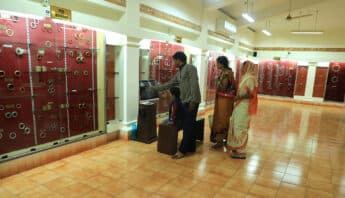


Gallery 1
Personal Adornment
An introduction to the many tribal communities that live in Odisha, told through a display of their unique attire and ornaments. The gallery is a tribute to the human sense of aesthetics, as expressed through attire and body ornamentation. Here the visitor can acquaint themselves with the traditional attire of several of Odisha’s tribal communities and gaze upon the intricately crafted items of personal adornment such as bangles, hairpins, necklaces, waistbands and earrings.
Gallery 2
Textiles, Personal Belongings, Art and Crafts
The gallery demonstrates the astounding skill and craftsmanship to be found among Odisha’s tribal communities through handcrafted combs, smoking pipes and purses alongside exquisite textiles, traditional paintings and beautiful examples of bamboo and paddy craft. Tribal communities such as the Juang, Koya, Kutia Kandha, Lanjia Saora, Santal, Bhottada and Dongria Kandha have crafted many of these beautiful objects. Hand woven textiles belonging to communities such as the Bonda, Munda, Santal, Dharua and Kandha are also part of the display.
Gallery 3
Hunting & Fishing Implements & Weapons of Offense and Defence
In this gallery, the skill at hunting is demonstrated along with the valour in defense of territory. Hunting and fishing implements, catapults, traps and snares are displayed alongside traditional weapons, bows, arrows, spears, axes, guns and swords. Apart from several intricate fishing traps designed to catch a variety of river fish, fishing spears, fish storage baskets and numerous fishing nets can be seen. Nets for trapping wild game as well as snares for rabbit, wild cock and other birds are also part of this display alongside traditional knives and axes that may be used for defence, clearing the forests and ceremonial sacrifices.


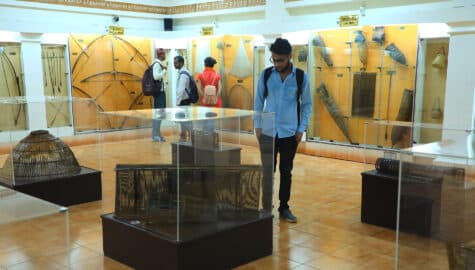
Gallery 1
Personal Adornment
An introduction to the many tribal communities that live in Odisha, told through a display of their unique attire and ornaments. The gallery is a tribute to the human sense of aesthetics, as expressed through attire and body ornamentation. Here the visitor can acquaint themselves with the traditional attire of several of Odisha’s tribal communities and gaze upon the intricately crafted items of personal adornment such as bangles, hairpins, necklaces, waistbands and earrings.
Gallery 2
Textiles, Personal Belongings, Art and Crafts
The gallery demonstrates the astounding skill and craftsmanship to be found among Odisha’s tribal communities through handcrafted combs, smoking pipes and purses alongside exquisite textiles, traditional paintings and beautiful examples of bamboo and paddy craft. Tribal communities such as the Juang, Koya, Kutia Kandha, Lanjia Saora, Santal, Bhottada and Dongria Kandha have crafted many of these beautiful objects. Hand woven textiles belonging to communities such as the Bonda, Munda, Santal, Dharua and Kandha are also part of the display.
Gallery 3
Hunting & Fishing Implements & Weapons of Offense and Defence
In this gallery, the skill at hunting is demonstrated along with the valour in defense of territory. Hunting and fishing implements, catapults, traps and snares are displayed alongside traditional weapons, bows, arrows, spears, axes, guns and swords. Apart from several intricate fishing traps designed to catch a variety of river fish, fishing spears, fish storage baskets and numerous fishing nets can be seen. Nets for trapping wild game as well as snares for rabbit, wild cock and other birds are also part of this display alongside traditional knives and axes that may be used for defence, clearing the forests and ceremonial sacrifices.
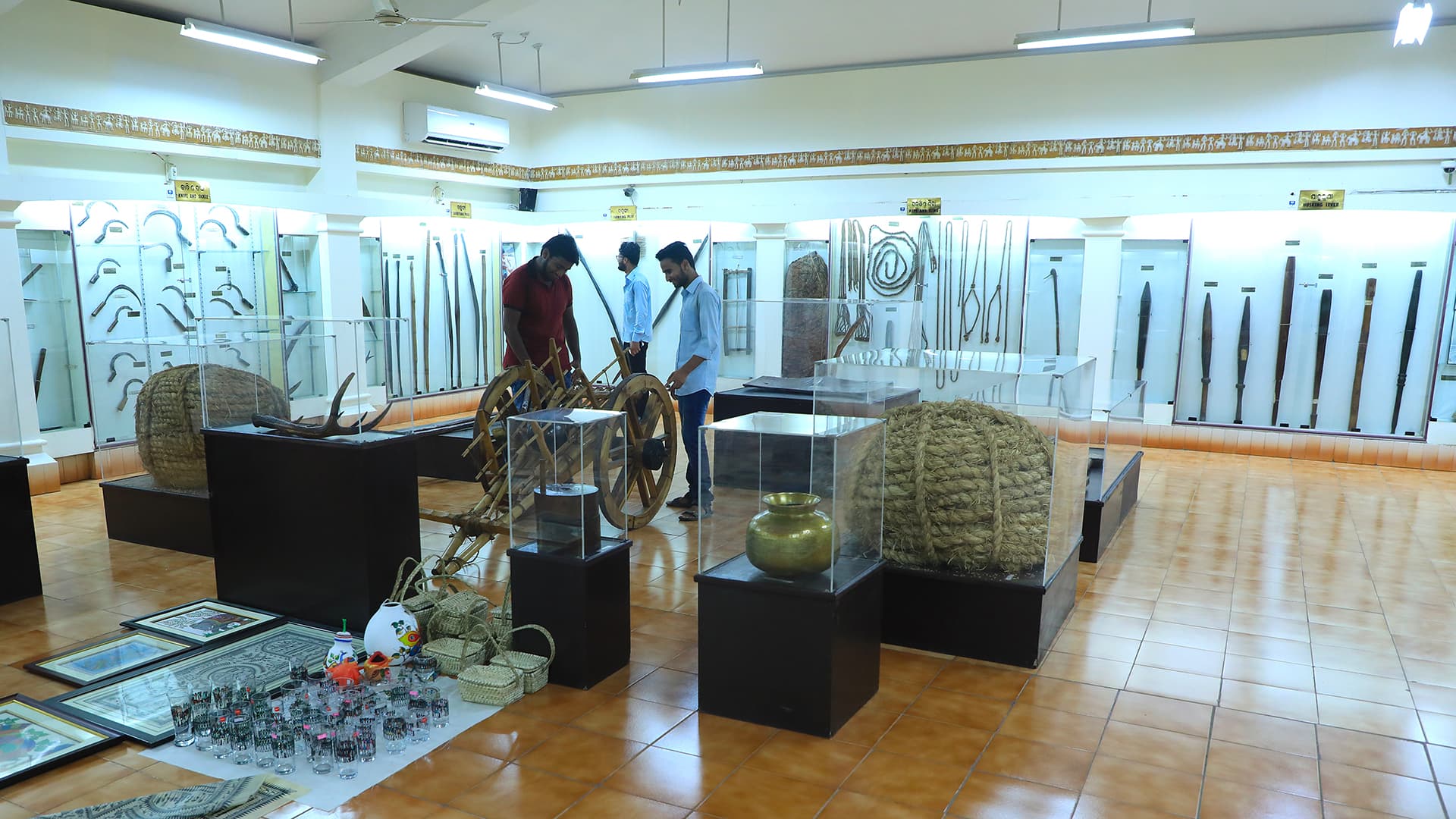
Gallery 4
Household Objects and Agricultural Implements
Depicting the simple life of home and hearth, in this gallery one finds rudimentary tools for cultivation as well as an array of household utensils, knifes, containers and inventive utilities for sheltering from the rain, twisting rope and pressing oil. A variety of measuring containers as well as utensils made of dried gourd are also displayed along with digging sticks, straw collectors, levellers, ploughs, winnows and pestles. Allied household objects such as goat and cowbells, ropes, slings and carrying poles are also exhibited in this gallery.


Gallery 3
Hunting & Fishing Implements & Weapons of Offense and Defence
In this gallery, the skill at hunting is demonstrated along with the valour in defense of territory. Hunting and fishing implements, catapults, traps and snares are displayed alongside traditional weapons, bows, arrows, spears, axes, guns and swords. Apart from several intricate fishing traps designed to catch a variety of river fish, fishing spears, fish storage baskets and numerous fishing nets can be seen. Nets for trapping wild game as well as snares for rabbit, wild cock and other birds are also part of this display alongside traditional knives and axes that may be used for defence, clearing the forests and ceremonial sacrifices.
Gallery 4
Household Objects and Agricultural Implements
Depicting the simple life of home and hearth, in this gallery one finds rudimentary tools for cultivation as well as an array of household utensils, knifes, containers and inventive utilities for sheltering from the rain, twisting rope and pressing oil. A variety of measuring containers as well as utensils made of dried gourd are also displayed along with digging sticks, straw collectors, levellers, ploughs, winnows and pestles. Allied household objects such as goat and cowbells, ropes, slings and carrying poles are also exhibited in this gallery.

Gallery 5
Dance, Musical Instruments and Dhokra Items
An ode to the joys of celebration, this gallery houses a collection of musical instruments; brass and horn trumpets, drums, cymbals, clappers and tambourines. Large drums made for dancing on festive occasions share space with special dancing costumes, string and percussion instruments, shakers, Jews harps and friction blocks. In addition, this gallery also houses an exquisite collection of Dhokra figurines. Made using the ancient process of lost wax casting, these figurines serve ritual as well as decorative purpose and depict humans, animals, birds and insects.
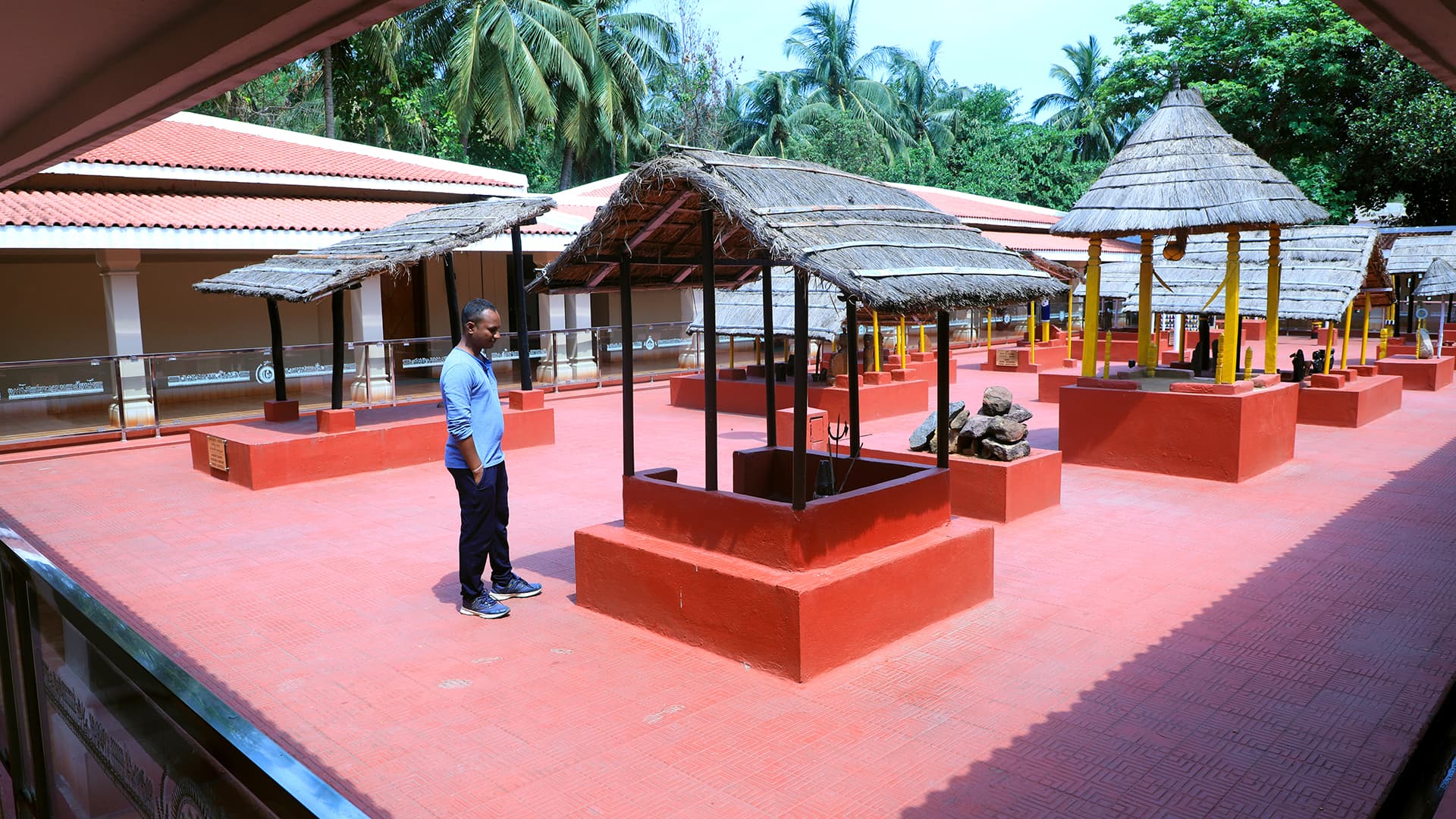
Courtyard, Main Building
Tribal Shrines
In the courtyard of the main museum building are 14 tribal shrines honouring spirits, gods and goddesses, viz.
1. Gudi: Shrine of village deity Bhima and Bhimsen of Bhottada community who are worshipped for good harvest, freedom from disease and natural calamity.
2. Birkam Asan: Shrine of the village goddess, Birkam Devta of the Bhumia who is propitiated for the well being of villagers and cattle, bumper harvests and prevention of disease in the village.
Show More
4. Ladridokri Deo, Bhandar dokri Deo: The village deity Ladridokri Deo of Dharua tribe, is enshrined with Bhandar dokri Deo. Both deities are supposed to protect against natural calamities, cholera, death of animals and birds, illness and disease.
5. Birhu and Hundi: Within the sacred enclosure called Gulisang are located shrines of Birhu, the earth goddess and Hundi, the village deity of the Didayi. They are venerated for soil fertility, heath of children and cattle, plentiful harvest and wild game.
6. Kotyuewali Penu Kotiasal: Shrine of Kotyuewali Penu, the consort of the earth goddess Dharni Penu worshipped by the Dongria Kandha. The deity is considered as the village guardian who watches over and protects the village.
7. Gudighar: Shrine of the village deity, Dharni Devta of Holva tribe. Sacrifices are offered here during March-April to ensure good harvest and health of the villagers and cattle.
8. Mandua Sum: Village deity of the Lanjia Saora, he is believed to protect the village from misfortune and calamities and is worshipped for the health and well being of the village.
9. Jhanker: A decorated Meriah post or sacrificial pillar of the Kandha community. The pillar is installed close to the shrine of the earth goddess, Dharni Penu. Here, the community offer sacrificial buffaloes to the goddess during the Kedu festival.
10. Maa Dulari Devi: The village deity of the Koya, is installed along with other ritual objects. She is worshipped to ensure bumper harvest, successful hunting expeditions and relief in case of natural calamities.
11. Jananglo Sum: The wind deity of the Lanjia Saora is believed to protect the shrine of their village deity Mandua Sum as well as the entire village from bad weather and storms. He is also worshipped to cure serious illnesses and during the first eating ceremonies for sweet potato and red gram.
12. Gudighar: Shrine of Duarmundi Thakurani, the village deity of the Paroja. She is worshipped to ensure a good harvest, protection against disease and natural calamities, improvement of livestock and development of brotherhood among the community.
13. Thakrani Gudi: Shrine for Bhima Thakrani, the village deity of the Pentia, the seven sisters and Maa Thakrani. Offerings are made to the deities so that they bless the village with good health and a bumper harvest.
14. Jaher Garh: At the centre of this sacred grove, in a shed called Jaherthan, the Santal deities, Marangburu, Gosane, Jaher era, Maneko, Turuiko and Pargana Bonga are worshipped so that the village may have a good harvest and be safeguarded against disease and natural calamities.
Show Less

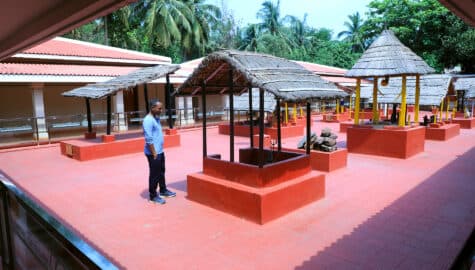
Gallery 5
Dance, Musical Instruments and Dhokra Items
An ode to the joys of celebration, this gallery houses a collection of musical instruments; brass and horn trumpets, drums, cymbals, clappers and tambourines. Large drums made for dancing on festive occasions share space with special dancing costumes, string and percussion instruments, shakers, Jews harps and friction blocks. In addition, this gallery also houses an exquisite collection of Dhokra figurines. Made using the ancient process of lost wax casting, these figurines serve ritual as well as decorative purpose and depict humans, animals, birds and insects.
Courtyard, Main Building
Tribal Shrines
In the courtyard of the main museum building are 14 tribal shrines honouring spirits, gods and goddesses, viz.
1. Gudi: Shrine of village deity Bhima and Bhimsen of Bhottada community who are worshipped for good harvest, freedom from disease and natural calamity.
2. Birkam Asan: Shrine of the village goddess, Birkam Devta of the Bhumia who is propitiated for the well being of villagers and cattle, bumper harvests and prevention of disease in the village.
Show More
4. Ladridokri Deo, Bhandar dokri Deo: The village deity Ladridokri Deo of Dharua tribe, is enshrined with Bhandar dokri Deo. Both deities are supposed to protect against natural calamities, cholera, death of animals and birds, illness and disease.
5. Birhu and Hundi: Within the sacred enclosure called Gulisang are located shrines of Birhu, the earth goddess and Hundi, the village deity of the Didayi. They are venerated for soil fertility, heath of children and cattle, plentiful harvest and wild game.
6. Kotyuewali Penu Kotiasal: Shrine of Kotyuewali Penu, the consort of the earth goddess Dharni Penu worshipped by the Dongria Kandha. The deity is considered as the village guardian who watches over and protects the village.
7. Gudighar: Shrine of the village deity, Dharni Devta of Holva tribe. Sacrifices are offered here during March-April to ensure good harvest and health of the villagers and cattle.
8. Mandua Sum: Village deity of the Lanjia Saora, he is believed to protect the village from misfortune and calamities and is worshipped for the health and well being of the village.
9. Jhanker: A decorated Meriah post or sacrificial pillar of the Kandha community. The pillar is installed close to the shrine of the earth goddess, Dharni Penu. Here, the community offer sacrificial buffaloes to the goddess during the Kedu festival.
10. Maa Dulari Devi: The village deity of the Koya, is installed along with other ritual objects. She is worshipped to ensure bumper harvest, successful hunting expeditions and relief in case of natural calamities.
11. Jananglo Sum: The wind deity of the Lanjia Saora is believed to protect the shrine of their village deity Mandua Sum as well as the entire village from bad weather and storms. He is also worshipped to cure serious illnesses and during the first eating ceremonies for sweet potato and red gram.
12. Gudighar: Shrine of Duarmundi Thakurani, the village deity of the Paroja. She is worshipped to ensure a good harvest, protection against disease and natural calamities, improvement of livestock and development of brotherhood among the community.
13. Thakrani Gudi: Shrine for Bhima Thakrani, the village deity of the Pentia, the seven sisters and Maa Thakrani. Offerings are made to the deities so that they bless the village with good health and a bumper harvest.
14. Jaher Garh: At the centre of this sacred grove, in a shed called Jaherthan, the Santal deities, Marangburu, Gosane, Jaher era, Maneko, Turuiko and Pargana Bonga are worshipped so that the village may have a good harvest and be safeguarded against disease and natural calamities.
Show Less
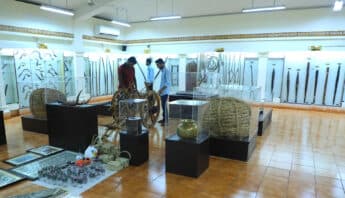


Gallery 4
Household Objects and Agricultural Implements
Depicting the simple life of home and hearth, in this gallery one finds rudimentary tools for cultivation as well as an array of household utensils, knifes, containers and inventive utilities for sheltering from the rain, twisting rope and pressing oil. A variety of measuring containers as well as utensils made of dried gourd are also displayed along with digging sticks, straw collectors, levellers, ploughs, winnows and pestles. Allied household objects such as goat and cowbells, ropes, slings and carrying poles are also exhibited in this gallery.
Gallery 5
Dance, Musical Instruments and Dhokra Items
An ode to the joys of celebration, this gallery houses a collection of musical instruments; brass and horn trumpets, drums, cymbals, clappers and tambourines. Large drums made for dancing on festive occasions share space with special dancing costumes, string and percussion instruments, shakers, Jews harps and friction blocks. In addition, this gallery also houses an exquisite collection of Dhokra figurines. Made using the ancient process of lost wax casting, these figurines serve ritual as well as decorative purpose and depict humans, animals, birds and insects.
Courtyard, Main Building
Tribal Shrines
In the courtyard of the main museum building are 14 tribal shrines honouring spirits, gods and goddesses, viz.
1. Gudi: Shrine of village deity Bhima and Bhimsen of Bhottada community who are worshipped for good harvest, freedom from disease and natural calamity.
2. Birkam Asan: Shrine of the village goddess, Birkam Devta of the Bhumia who is propitiated for the well being of villagers and cattle, bumper harvests and prevention of disease in the village.
Show More
4. Ladridokri Deo, Bhandar dokri Deo: The village deity Ladridokri Deo of Dharua tribe, is enshrined with Bhandar dokri Deo. Both deities are supposed to protect against natural calamities, cholera, death of animals and birds, illness and disease.
5. Birhu and Hundi: Within the sacred enclosure called Gulisang are located shrines of Birhu, the earth goddess and Hundi, the village deity of the Didayi. They are venerated for soil fertility, heath of children and cattle, plentiful harvest and wild game.
6. Kotyuewali Penu Kotiasal: Shrine of Kotyuewali Penu, the consort of the earth goddess Dharni Penu worshipped by the Dongria Kandha. The deity is considered as the village guardian who watches over and protects the village.
7. Gudighar: Shrine of the village deity, Dharni Devta of Holva tribe. Sacrifices are offered here during March-April to ensure good harvest and health of the villagers and cattle.
8. Mandua Sum: Village deity of the Lanjia Saora, he is believed to protect the village from misfortune and calamities and is worshipped for the health and well being of the village.
9. Jhanker: A decorated Meriah post or sacrificial pillar of the Kandha community. The pillar is installed close to the shrine of the earth goddess, Dharni Penu. Here, the community offer sacrificial buffaloes to the goddess during the Kedu festival.
10. Maa Dulari Devi: The village deity of the Koya, is installed along with other ritual objects. She is worshipped to ensure bumper harvest, successful hunting expeditions and relief in case of natural calamities.
11. Jananglo Sum: The wind deity of the Lanjia Saora is believed to protect the shrine of their village deity Mandua Sum as well as the entire village from bad weather and storms. He is also worshipped to cure serious illnesses and during the first eating ceremonies for sweet potato and red gram.
12. Gudighar: Shrine of Duarmundi Thakurani, the village deity of the Paroja. She is worshipped to ensure a good harvest, protection against disease and natural calamities, improvement of livestock and development of brotherhood among the community.
13. Thakrani Gudi: Shrine for Bhima Thakrani, the village deity of the Pentia, the seven sisters and Maa Thakrani. Offerings are made to the deities so that they bless the village with good health and a bumper harvest.
14. Jaher Garh: At the centre of this sacred grove, in a shed called Jaherthan, the Santal deities, Marangburu, Gosane, Jaher era, Maneko, Turuiko and Pargana Bonga are worshipped so that the village may have a good harvest and be safeguarded against disease and natural calamities.
Show Less



Gallery 4
Household Objects and Agricultural Implements
Depicting the simple life of home and hearth, in this gallery one finds rudimentary tools for cultivation as well as an array of household utensils, knifes, containers and inventive utilities for sheltering from the rain, twisting rope and pressing oil. A variety of measuring containers as well as utensils made of dried gourd are also displayed along with digging sticks, straw collectors, levellers, ploughs, winnows and pestles. Allied household objects such as goat and cowbells, ropes, slings and carrying poles are also exhibited in this gallery.
Gallery 5
Dance, Musical Instruments and Dhokra Items
An ode to the joys of celebration, this gallery houses a collection of musical instruments; brass and horn trumpets, drums, cymbals, clappers and tambourines. Large drums made for dancing on festive occasions share space with special dancing costumes, string and percussion instruments, shakers, Jews harps and friction blocks. In addition, this gallery also houses an exquisite collection of Dhokra figurines. Made using the ancient process of lost wax casting, these figurines serve ritual as well as decorative purpose and depict humans, animals, birds and insects.
Courtyard, Main Building
Tribal Shrines
In the courtyard of the main museum building are 14 tribal shrines honouring spirits, gods and goddesses, viz.
1. Gudi: Shrine of village deity Bhima and Bhimsen of Bhottada community who are worshipped for good harvest, freedom from disease and natural calamity.
2. Birkam Asan: Shrine of the village goddess, Birkam Devta of the Bhumia who is propitiated for the well being of villagers and cattle, bumper harvests and prevention of disease in the village.
Show More
4. Ladridokri Deo, Bhandar dokri Deo: The village deity Ladridokri Deo of Dharua tribe, is enshrined with Bhandar dokri Deo. Both deities are supposed to protect against natural calamities, cholera, death of animals and birds, illness and disease.
5. Birhu and Hundi: Within the sacred enclosure called Gulisang are located shrines of Birhu, the earth goddess and Hundi, the village deity of the Didayi. They are venerated for soil fertility, heath of children and cattle, plentiful harvest and wild game.
6. Kotyuewali Penu Kotiasal: Shrine of Kotyuewali Penu, the consort of the earth goddess Dharni Penu worshipped by the Dongria Kandha. The deity is considered as the village guardian who watches over and protects the village.
7. Gudighar: Shrine of the village deity, Dharni Devta of Holva tribe. Sacrifices are offered here during March-April to ensure good harvest and health of the villagers and cattle.
8. Mandua Sum: Village deity of the Lanjia Saora, he is believed to protect the village from misfortune and calamities and is worshipped for the health and well being of the village.
9. Jhanker: A decorated Meriah post or sacrificial pillar of the Kandha community. The pillar is installed close to the shrine of the earth goddess, Dharni Penu. Here, the community offer sacrificial buffaloes to the goddess during the Kedu festival.
10. Maa Dulari Devi: The village deity of the Koya, is installed along with other ritual objects. She is worshipped to ensure bumper harvest, successful hunting expeditions and relief in case of natural calamities.
11. Jananglo Sum: The wind deity of the Lanjia Saora is believed to protect the shrine of their village deity Mandua Sum as well as the entire village from bad weather and storms. He is also worshipped to cure serious illnesses and during the first eating ceremonies for sweet potato and red gram.
12. Gudighar: Shrine of Duarmundi Thakurani, the village deity of the Paroja. She is worshipped to ensure a good harvest, protection against disease and natural calamities, improvement of livestock and development of brotherhood among the community.
13. Thakrani Gudi: Shrine for Bhima Thakrani, the village deity of the Pentia, the seven sisters and Maa Thakrani. Offerings are made to the deities so that they bless the village with good health and a bumper harvest.
14. Jaher Garh: At the centre of this sacred grove, in a shed called Jaherthan, the Santal deities, Marangburu, Gosane, Jaher era, Maneko, Turuiko and Pargana Bonga are worshipped so that the village may have a good harvest and be safeguarded against disease and natural calamities.
Show Less

Special Gallery
PVTG World
Through a colourful combination of diorama and interactive kiosk, this gallery serves as an introduction to the life and culture of the 13 Particularly Vulnerable Tribal Communities that live in Odisha, namely Bonda, Chuktia Bhunjia, Didayi, Dongria Kandha, Hill Kharia, Juang, Kutia Kandha, Lodha, Lanjia Saora , Mankirdia / Birhor, Paudi Bhuinya and Saora.

Outdoor Exhibition
Tribal Huts
Recreations of traditional tribal dwellings, with their traditional demarcations of living, dining, cooking and praying areas; with separate cow shed and pig sty, these tribal huts contain a collection of household, agricultural and hunting implements. The 7 recreated dwellings belong to the Santal, Juang, Gadaba, Saora, Kandha, Gond and Chuktia Bhunjia communities.
Show More
Juang Hut and Dormitory: The Juang hut has a single door, and no windows. This one room dwelling has a wooden platform on which grain is stored, and a hearth in addition to a mortar at the doorway. Also called Mandaghar, the Juang bachelors’ dormitory is where all unmarried boys of the village sleep at night. During the day it is used for village meetings and a fire is kept burning here year around. (Virtual Tour)
Santal Hut: The Santal hut is L-shaped with mud walls. The roof is supported on wooden pillars covered with straw or tiles. The hut includes a main living space, hearth, store, verandah and a cattle shed. (Virtual Tour)
Gond Hut: A single room dwelling, the Gond hut has a covered verandah on three sides. The walls of the hut are brightly painted with traditional Gond art. One part of the covered verandah is the family hearth while the other is used to store fishing implements. (Virtual Tour)
Lanjia Saora Hut: The Lanjia Saora hut is a single room dwelling. At one end a high wooden platform is used to store grain. Below it is the hearth and a small shrine. On the opposite end is the idital, a ritual painting made to appease various spirits. The pigsty and fowl pen are located under the verandah. (Virtual Tour)
Chuktia Bhunjia Hut: The hut is made of wooden posts plastered with mud. The main living space is sufficient to accommodate a married couple and their children. A verandah runs the length of the hut and is used to entertain guests. The kitchen is a scared space and is built separate from the main hut. Only family members are allowed to enter this space. (Virtual Tour)
Gadaba Hut: The traditional Gadaba hut is circular in construction. The roof is supported by a central wooden pole, within which the hut deity is said to reside. Internally the hut is divided into a main living space, a kitchen with a hearth and an inner room. This inner room is reserved for the family deities, and has its own hearth. (Virtual Tour)
Show Less


Special Gallery
PVTG World
Through a colourful combination of diorama and interactive kiosk, this gallery serves as an introduction to the life and culture of the 13 Particularly Vulnerable Tribal Communities that live in Odisha, namely Bonda, Chuktia Bhunjia, Didayi, Dongria Kandha, Hill Kharia, Juang, Kutia Kandha, Lodha, Lanjia Saora , Mankirdia / Birhor, Paudi Bhuinya and Saora.
Outdoor Exhibition
Tribal Huts
Recreations of traditional tribal dwellings, with their traditional demarcations of living, dining, cooking and praying areas; with separate cow shed and pig sty, these tribal huts contain a collection of household, agricultural and hunting implements. The 7 recreated dwellings belong to the Santal, Juang, Gadaba, Saora, Kandha, Gond and Chuktia Bhunjia communities.
Show More
Juang Hut and Dormitory: The Juang hut has a single door, and no windows. This one room dwelling has a wooden platform on which grain is stored, and a hearth in addition to a mortar at the doorway. Also called Mandaghar, the Juang bachelors’ dormitory is where all unmarried boys of the village sleep at night. During the day it is used for village meetings and a fire is kept burning here year around. (Virtual Tour)
Santal Hut: The Santal hut is L-shaped with mud walls. The roof is supported on wooden pillars covered with straw or tiles. The hut includes a main living space, hearth, store, verandah and a cattle shed. (Virtual Tour)
Gond Hut: A single room dwelling, the Gond hut has a covered verandah on three sides. The walls of the hut are brightly painted with traditional Gond art. One part of the covered verandah is the family hearth while the other is used to store fishing implements. (Virtual Tour)
Lanjia Saora Hut: The Lanjia Saora hut is a single room dwelling. At one end a high wooden platform is used to store grain. Below it is the hearth and a small shrine. On the opposite end is the idital, a ritual painting made to appease various spirits. The pigsty and fowl pen are located under the verandah. (Virtual Tour)
Chuktia Bhunjia Hut: The hut is made of wooden posts plastered with mud. The main living space is sufficient to accommodate a married couple and their children. A verandah runs the length of the hut and is used to entertain guests. The kitchen is a scared space and is built separate from the main hut. Only family members are allowed to enter this space. (Virtual Tour)
Gadaba Hut: The traditional Gadaba hut is circular in construction. The roof is supported by a central wooden pole, within which the hut deity is said to reside. Internally the hut is divided into a main living space, a kitchen with a hearth and an inner room. This inner room is reserved for the family deities, and has its own hearth. (Virtual Tour)
Show Less

Outdoor Exhibition
Herbal Garden
As an introduction to the biodiversity of Odisha, an herbal garden of over 300 medicinal plants has been created in the premises of the museum. This garden helps orient a growing number of tourists to the eco-friendly practices and indigenous knowledge of herbal remedies of Odisha’s tribal communities.



Special Gallery
PVTG World
Through a colourful combination of diorama and interactive kiosk, this gallery serves as an introduction to the life and culture of the 13 Particularly Vulnerable Tribal Communities that live in Odisha, namely Bonda, Chuktia Bhunjia, Didayi, Dongria Kandha, Hill Kharia, Juang, Kutia Kandha, Lodha, Lanjia Saora , Mankirdia / Birhor, Paudi Bhuinya and Saora.
Outdoor Exhibition
Tribal Huts
Recreations of traditional tribal dwellings, with their traditional demarcations of living, dining, cooking and praying areas; with separate cow shed and pig sty, these tribal huts contain a collection of household, agricultural and hunting implements. The 7 recreated dwellings belong to the Santal, Juang, Gadaba, Saora, Kandha, Gond and Chuktia Bhunjia communities.
Show More
Juang Hut and Dormitory: The Juang hut has a single door, and no windows. This one room dwelling has a wooden platform on which grain is stored, and a hearth in addition to a mortar at the doorway. Also called Mandaghar, the Juang bachelors’ dormitory is where all unmarried boys of the village sleep at night. During the day it is used for village meetings and a fire is kept burning here year around. (Virtual Tour)
Santal Hut: The Santal hut is L-shaped with mud walls. The roof is supported on wooden pillars covered with straw or tiles. The hut includes a main living space, hearth, store, verandah and a cattle shed. (Virtual Tour)
Gond Hut: A single room dwelling, the Gond hut has a covered verandah on three sides. The walls of the hut are brightly painted with traditional Gond art. One part of the covered verandah is the family hearth while the other is used to store fishing implements. (Virtual Tour)
Lanjia Saora Hut: The Lanjia Saora hut is a single room dwelling. At one end a high wooden platform is used to store grain. Below it is the hearth and a small shrine. On the opposite end is the idital, a ritual painting made to appease various spirits. The pigsty and fowl pen are located under the verandah. (Virtual Tour)
Chuktia Bhunjia Hut: The hut is made of wooden posts plastered with mud. The main living space is sufficient to accommodate a married couple and their children. A verandah runs the length of the hut and is used to entertain guests. The kitchen is a scared space and is built separate from the main hut. Only family members are allowed to enter this space. (Virtual Tour)
Gadaba Hut: The traditional Gadaba hut is circular in construction. The roof is supported by a central wooden pole, within which the hut deity is said to reside. Internally the hut is divided into a main living space, a kitchen with a hearth and an inner room. This inner room is reserved for the family deities, and has its own hearth. (Virtual Tour)
Show Less
Outdoor Exhibition
Herbal Garden
As an introduction to the biodiversity of Odisha, an herbal garden of over 300 medicinal plants has been created in the premises of the museum. This garden helps orient a growing number of tourists to the eco-friendly practices and indigenous knowledge of herbal remedies of Odisha’s tribal communities.



Special Gallery
PVTG World
Through a colourful combination of diorama and interactive kiosk, this gallery serves as an introduction to the life and culture of the 13 Particularly Vulnerable Tribal Communities that live in Odisha, namely Bonda, Chuktia Bhunjia, Didayi, Dongria Kandha, Hill Kharia, Juang, Kutia Kandha, Lodha, Lanjia Saora , Mankirdia / Birhor, Paudi Bhuinya and Saora.
Outdoor Exhibition
Tribal Huts
Recreations of traditional tribal dwellings, with their traditional demarcations of living, dining, cooking and praying areas; with separate cow shed and pig sty, these tribal huts contain a collection of household, agricultural and hunting implements. The 7 recreated dwellings belong to the Santal, Juang, Gadaba, Saora, Kandha, Gond and Chuktia Bhunjia communities.
Show More
Juang Hut and Dormitory: The Juang hut has a single door, and no windows. This one room dwelling has a wooden platform on which grain is stored, and a hearth in addition to a mortar at the doorway. Also called Mandaghar, the Juang bachelors’ dormitory is where all unmarried boys of the village sleep at night. During the day it is used for village meetings and a fire is kept burning here year around. (Virtual Tour)
Santal Hut: The Santal hut is L-shaped with mud walls. The roof is supported on wooden pillars covered with straw or tiles. The hut includes a main living space, hearth, store, verandah and a cattle shed. (Virtual Tour)
Gond Hut: A single room dwelling, the Gond hut has a covered verandah on three sides. The walls of the hut are brightly painted with traditional Gond art. One part of the covered verandah is the family hearth while the other is used to store fishing implements. (Virtual Tour)
Lanjia Saora Hut: The Lanjia Saora hut is a single room dwelling. At one end a high wooden platform is used to store grain. Below it is the hearth and a small shrine. On the opposite end is the idital, a ritual painting made to appease various spirits. The pigsty and fowl pen are located under the verandah. (Virtual Tour)
Chuktia Bhunjia Hut: The hut is made of wooden posts plastered with mud. The main living space is sufficient to accommodate a married couple and their children. A verandah runs the length of the hut and is used to entertain guests. The kitchen is a scared space and is built separate from the main hut. Only family members are allowed to enter this space. (Virtual Tour)
Gadaba Hut: The traditional Gadaba hut is circular in construction. The roof is supported by a central wooden pole, within which the hut deity is said to reside. Internally the hut is divided into a main living space, a kitchen with a hearth and an inner room. This inner room is reserved for the family deities, and has its own hearth. (Virtual Tour)
Show Less
Outdoor Exhibition
Herbal Garden
As an introduction to the biodiversity of Odisha, an herbal garden of over 300 medicinal plants has been created in the premises of the museum. This garden helps orient a growing number of tourists to the eco-friendly practices and indigenous knowledge of herbal remedies of Odisha’s tribal communities.

Shop
Souvenir Shop
In an effort to conserve and promote the traditional art forms of tribal communities, the Museum organizes bi-monthly Live Demonstration programs. The works produced during these demonstration programs are available for sale at the museum. In addition, the Souvenir Shop at the Museum also sells a range of tribal handicrafts, textiles and organic produce.


Outdoor Exhibition
Herbal Garden
As an introduction to the biodiversity of Odisha, an herbal garden of over 300 medicinal plants has been created in the premises of the museum. This garden helps orient a growing number of tourists to the eco-friendly practices and indigenous knowledge of herbal remedies of Odisha’s tribal communities.
Shop
Souvenir Shop
In an effort to conserve and promote the traditional art forms of tribal communities, the Museum organizes bi-monthly Live Demonstration programs. The works produced during these demonstration programs are available for sale at the museum. In addition, the Souvenir Shop at the Museum also sells a range of tribal handicrafts, textiles and organic produce.
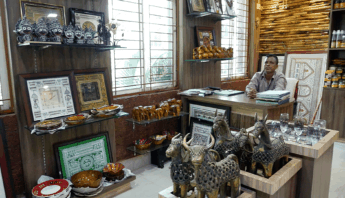
Shop
Souvenir Shop
In an effort to conserve and promote the traditional art forms of tribal communities, the Museum organizes bi-monthly Live Demonstration programs. The works produced during these demonstration programs are available for sale at the museum. In addition, the Souvenir Shop at the Museum also sells a range of tribal handicrafts, textiles and organic produce.

Shop
Souvenir Shop
In an effort to conserve and promote the traditional art forms of tribal communities, the Museum organizes bi-monthly Live Demonstration programs. The works produced during these demonstration programs are available for sale at the museum. In addition, the Souvenir Shop at the Museum also sells a range of tribal handicrafts, textiles and organic produce.




